





J. Ross Browne’s Whaling Station was a fine dining seafood restaurant chain located on S. Westnedge in Portage. The eye-catching exterior of the building resembled a coastal station, topped with a lighthouse.
The restaurants interior was much like a nautical museum, featuring nautical antiques and reproductions from all over the country. The restaurant cost $1.2 million to build and had an expansive interior (10,400 sq. ft.) and could seat up to 250 guests. The inside was styled with wood and wicker to mimic a captain’s cabin, set off with brass trim and fixtures. Many former patrons recall the huge wooden boat hanging from the ceiling and the ship’s wheel, salad bar in its own room.
Lunch was served Mon. – Fri. from 11am -2pm, with fare ranging from crab quiche to French dip sandwiches. The dinner menu was known for their steak & lobster. They served their full dinner menu Mon. – Thurs. 5-11pm, Fri. & Sat. from 5pm-midnight and Sunday Noon – 10pm.
They offered easy listening entertainment during evening hours and the cocktail lounge was open seven days a week until 1am. Many former patrons recall enjoying the music of the Andy Paul Band, Home, Jerry Brown, Neil Harding and many others.
Many share their fond memories of J. Ross Browne’s
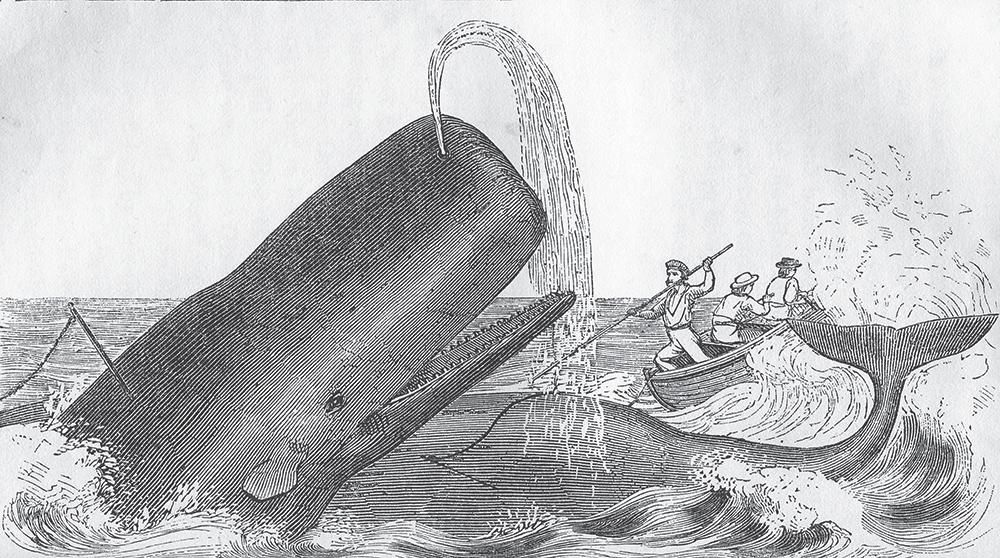
Whaling Station on the popular Vanished Kalamazoo facebook page, including: “Fantastic food!” “Whaling Station was awesome.” “I was a hostess there while attending WMU. My uniform was a long, maroon gown. “Great happy hour!” Loved that place!” “It was a great date night for us!” “Played many a gig there.” “Spent many TGIF’s there” “Loved that place, my roommate in the 80’s worked there, and one of our high school teachers was a regular in the bar.” “I loved the Whaling Station.”
“When I worked at Crossroads in the early 80’s we used to go there after work for drinks. Jerry Brown would play there once in a while and I never missed him!” “All I remember is they used to have a net way up on a big mast out front, and my parents would tell me that’s where people would put kids when they were bad...I tried very hard to not be bad.” “Had my very first date there
and it was also my prom date.”
The restaurant was named after John Ross Browne, often called J. Ross Browne, born on February 11, 1821 in Beggers Bush, Dublin, Ireland. J. Ross Browne was an Irishborn American traveler, who worked several years on a riverboat, before he signed on to a whaling ship. In 1846 he published a book “Etchings of a Whaling Cruise,” which earned him recognition as an artist and writer. He was also a government agent before his passing on December 9, 1875 in Oakland, California at the age of 54.
J. Ross Browne’s Whaling Station was part of Ralston Purina Corporation, which was not only a leader in animal feed, pet food, and animal health products, as well as breakfast cereals, including Chex & Cookie Crisp. They later operated a number of chain restaurants across the country. They opened in this area, at 6701
S. Westnedge in Portage, during the late 1970’s, employing 45 full-time and more than 100 part-time workers. It was located where Logan’s Roadhouse stands today.
Barclays Seafood took over the space after the Whaling Station closed and it became Mountain Jack’s in the early 1990’s, which was also owned by Ralston Purina. The building was demolished and Logan’s Roadhouse was built in the same basic space.
Ralston Purina owned another popular local restaurant, Carlos Murphy’s, that opened in Kalamazoo on the corner of W. Main St. at U.S. 131 in December 1980.
The Ralston Purina Company was a St. Louis, Missouri, based American conglomerate that merged with Swiss food-giant, Nestle’s, on December 12, 2001.
Jackie Merriam

Sources: KG 7/31/79, Wikipedia.com, Vanished Kalamazoo/facebook.
A. Etchings of a Whaling Cruise, with Notes of a Sojourn on the Island of Zanzibar: To Which is Appended a Brief History of the Whale Fishery, Its Past and Present Condition, by J. Ross Browne (Harper & Brothers, 184
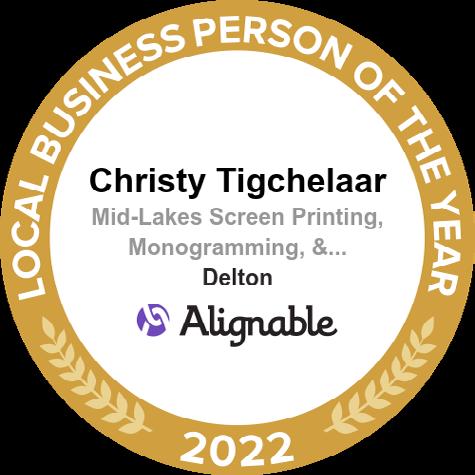




Anyone in close sympathy with flower and tree and shrub and has a general acquaintance with Nature’s moods could tell the time of year without any reference to a calendar”
Gertrude Jekyll, Home, and Garden, Magazine 1900
Phenology is the study of natural life cycle and seasonal events in the plant and animal world. These are influenced by the local environment, especially weather, temperature, seasonal change, and climate. Examples include the first dates of budding and blooming flowers, insects hatching, bird migration, and fall color. The word phenology comes from the Greek phaino meaning “to show, to bring to light or make appear.” Phenology is also called Traditional Ecological Knowledge (TEK).
Phenology dates back thousands of years and is one of the oldest branches of environmental science. Native Americans were experts at reading their regional landscapes. Their knowledge of “nature’s calendar” helped ensure their survival and kept them in harmony with the natural world. For Native Americans, phenology was a well-honed tool and plain common sense. Life revolved around seasonal cycles as they moved from one food source to another,

Groundhog Day, celebrated every year on February 2nd, is a quirky holiday that goes back hundreds of years as a European tradition and even in ancient times.

continually modifying their behavior in response to the life cycles of local plants and animals.
They kept track of the seasons by assigning descriptive names to each recurring full moon, alluding to notable phenological events during that month.
• When oak leaves were the size of a mouse’s ear it was time to plant corn.
• The emerging earthworm in March signaled the earth was beginning to thaw, and the time to tap maple trees was not far off.
Gardening by the calendar can sometimes be misleading, especially when deciding when to plant. Each gardening region has its own native species and seasonal timetable. Flowers vary in their bloom times depending on their location. For example, Joe pye weed might bloom in August in one area and September in another. But these plants will generally bloom at about the same time in any given locality from year to year.
In addition, biological events are not the same from one microclimate to another. They are influenced by local temperature, precipitation, day length, and proximity to buildings and other structures.
Phenology is valuable for scheduling seasonal tasks in your garden and
Its purpose is to predict the conclusion of winter and the onset of planting season.
The holiday is celebrated each year with a groundhog emerging from his burrow on Groundhog Day. If he sees his shadow, he will retreat, and there will be six more weeks of winter. If he doesn’t see his shadow, it is said that early spring weather is just around the corner. The most famous groundhog forecaster is Punxsutawney Phil, who lives in Pennsylvania. According to the National Oceanic Atmospheric Administration (NOAA), Punxsutawney Phil has accurately predicted the coming of spring 40% of the time. That’s not exactly a great track record.
Whether you believe that Punxsutawney Phil’s forecast, or are a

is a helpful tool for:
• Successful intergraded pest management of insect pests & diseases
• Designing flower beds for sequential bloom
• Planning for harvest season
• Planning gardens for beneficial insects
• Predicting when to plant the best plants for bees and other pollinators
• Preparing for allergy and mosquito season
Tracking phenophases, the visible stages in a plant’s or animal’s life cycle, provides gardeners with signals or cues for making good gardening decisions.
Observable life cycle events or PHENOPHASES in your garden
• Plant peas when the daffodils or the spring peepers sing
• When the flowers of the bleeding heart or Juneberry trees bloom, it’s safe to plant pansies, carrots, and fennel
• Crabgrass, a creepy pest in the garden, germinates when the soil temperature stabilizes at 55 degrees and coincides with the bloom cycle of forsythia and the perfect time to apply fertilizer to your garden.
• When you see milkweed pods and plumes of goldenrod, it’s time to finish harvesting and dry herbs for
cynic like Bill Murray in the 1993 Comedy movie, Groundhog Day, everyone can enjoy the frivolity of the holiday. If for no other reason than to break-up the monotony of winter. Tune into the livestream at visitpa. com, provided by Visit Pennsylvania, beginning at 6am on February 2nd.
According to our weather predictions, Sunday, February 2, 2025, will bring snow showers and cold weather, which predictors believe when Punxsutawney Phil emerges, he will NOT see his shadow, which indicates an early spring!
Jackie Merriam
the season.
If you keep a garden journal for seed lists, plant names, and locations, include your observations of the pheno– phases and microclimates unique to your garden and landscape.
Be sure to note:
• First and last frost dates
• Bird arrival dates
• Leaf out dates
• Insect emergence
• Blooming dates of native and non-native species, including trees, shrubs, flowers, herbs, weeds, and ornamentals. Early spring, midlate spring, early summer, midsummer, late summer, and fall
• High and low temperatures and precipitation
• Moon phases, summer and winter solstice, and equinox dates
To learn more about phenology and contribute the information collected and recorded from your local garden to educate others, please check out the following sites.
• The USA National Phenology Network
• Journey North
• Botanical Interests Free Garden Journal
After all, “More grows in a garden than a gardener sows.”
Susan M Betz, National Garden Bureau, https://ngb.org/phenology/

Graphic Designer: Lauren Ellis Editor and Publisher: Jackie Merriam (269) 217-0977 -
Often when I’m preparing to write another article, I’m spending days and weeks “gathering” inspiration and a theme to write on. It’s found through encounters with others. Travels. Art creation. Books I’m reading. Phrases and statements I hear. Facts that are intriguing.
I just learned that the average American spent 2.5 months on their smartphone last year. You shocked? I was. I felt guilty, as I am likely one of those Americans. That time cannot be returned. Time wasted. ‘Cause other than a few pics taken here and there, some text messages, and phone calls with friends and loved ones, that smartphone did not bring me any closer to my goals of health and happiness. Just review your search history—I’m sure many of us have spent too much time googling our symptoms, looking into gossip on celebs, and going down rabbit holes of useless information.
Back to my inspiration for this month: peace and joy.
No matter the differences between us, between myself and others, between you and others, we all are innately moved towards wanting and finding peace and joy.
We work towards this every day, sometimes with more focus and energy than other days, but we all strive for that same sense of control, sanity,
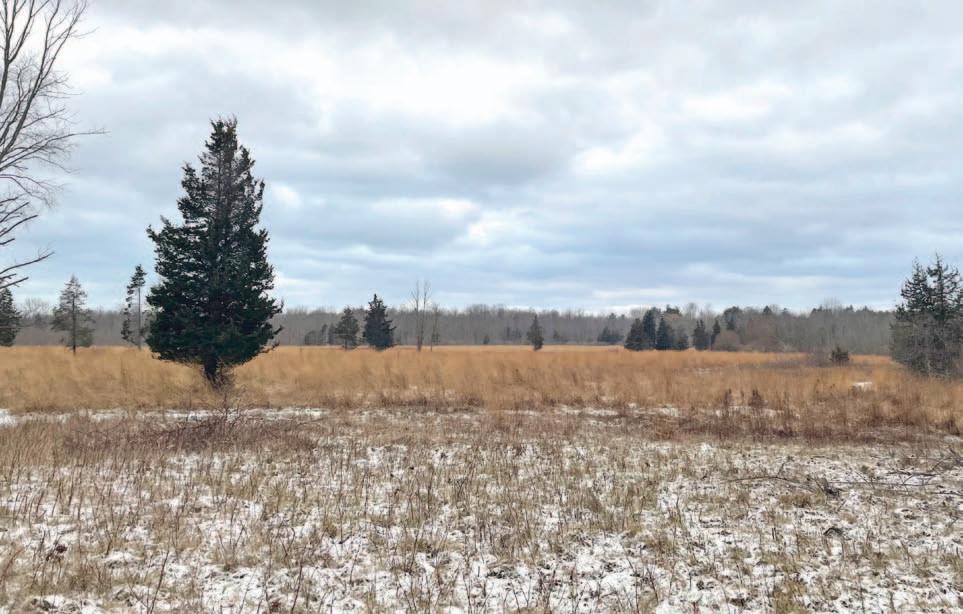
and solace. Unfortunately, this time is lost when we spend a lot of it scrolling on our phones.
So, what brings you joy and peace, love and contentment? Is it held by, created by, and gifted by others? Or, do you make it happen for yourself?
Don’t hold your breath waiting. It’s all around you, it’s already created, it’s already provided, but it does take a little attention and vision and action to find it. In the last few years, I’ve become more attuned to where I find the most peace and joy. Reading, working out, creating art, and being in the woods. I’m focused on a year of having more peace and joy and
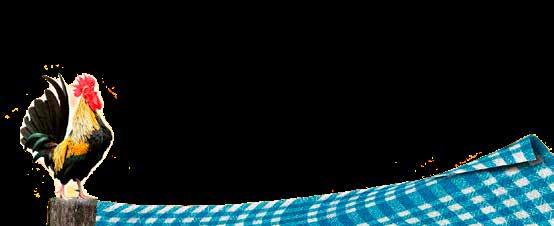
less noise and pull. What it looks like for me is: making sure my mornings start with coffee and reading, fitting a small workout into my afternoons, I hope to find myself moving along a trail in the woods on the weekend and have art on my kitchen table that is ready to begin, add to, or be completed.
One of the books I’m reading: “Don’t Believe Everything You Think,” by Joseph Nguyen explains stress reduction tied to the simplicity of thought. Here’s the skinny: having a thought=good, thinking too much = bad. Another book I’m reading: “Drinking from the River of Light”
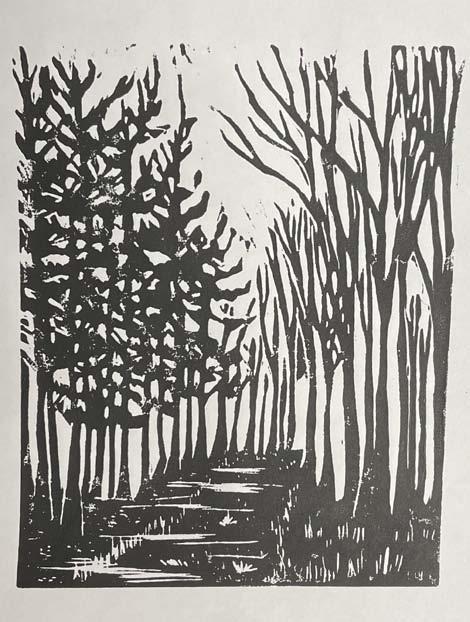
by Mark Nepo reminds me of the importance of creating; the act of creating as a part of self and sharing this gift with others. What I’m saying is: don’t overthinkmove into action. Think less. Create more. Follow your passions and spend time doing the things that create calm, the essence of the flow of peace and joy. And, if nothing else, get off your phone and get into the woods.
20 original art prints have been randomly placed in this issue of the Good News Paper.
Peace, Love, and Art. -Amy Instagram: @amylgieschen




Picture life in Greece in 1944—a country ravaged by WWII and an ensuing civil war. Both catastrophes devastated once-thriving cities and villages, collapsed the economy, destroyed jobs, caused rampant starvation, and led to societal collapse.
In this setting, a young man from Achladokambos, Gus Stamos, realized his future prospects were bleak—but not hopeless. Like many of his generation, he was drawn to the dream of “coming to America” for the promise of a better life.
Despite his inability to speak English and with nothing more than some clothing, the equivalent of a few dollars, and a resolute work ethic, Gus boarded a ship to begin a new life in a strange country.
He first arrived in Chicago, where there were countless job opportunities in restaurants for those willing to work long hours bussing tables or washing dishes. Through hard work, one could move up to prepping and cooking positions.
A year later, Gus settled in Kalamazoo, where a handful of distant relatives lived. He opened a small café in downtown Kalamazoo called the Rex Café.
Fully established in Kalamazoo, Gus sponsored his 14-year-old nephew, Pete Stamos, to come to America. At nineteen, Pete enlisted in the U.S. Army and served during the occupation of Germany. Affectionately referred to as “Poppa Pete” later on, he returned from military service to join his uncle at the Rex.
Pete went on to own several businesses in Kalamazoo, including the Char Steak Restaurant, located at the corner of Michigan Avenue and Rose Street, where the Radisson stands today.
In December 1991, Pete and his son Steve opened the Blue Dolphin, where Pete worked until his retire-




ment in 1998. Passing the torch, Pete’s son Steve assumed management of the Blue Dolphin from 1990 until just last year. As we begin 2025, Steve has proudly handed the reins to his son Pete, marking the fourth generation to steward the legacy of the Blue Dolphin.
Grandson Pete has already accomplished much in his young career. He earned a degree in finance and economics from prestigious Elmhurst College, where he was an All-American football player and later played professional football in Europe. Now, his passion is to continue the family business.
January 2025 marks the 80th anniversary of the Stamos family’s arrival and the opening of their first restaurant in Kalamazoo—a legacy of serving our community both within and outside of their restaurants.
The Stamos family’s attention wasn’t solely devoted to their restaurants. Appreciative of everything they received as citizens of this country, they have always felt the need to share their blessings. What began as an annual tradition in 1979 at the
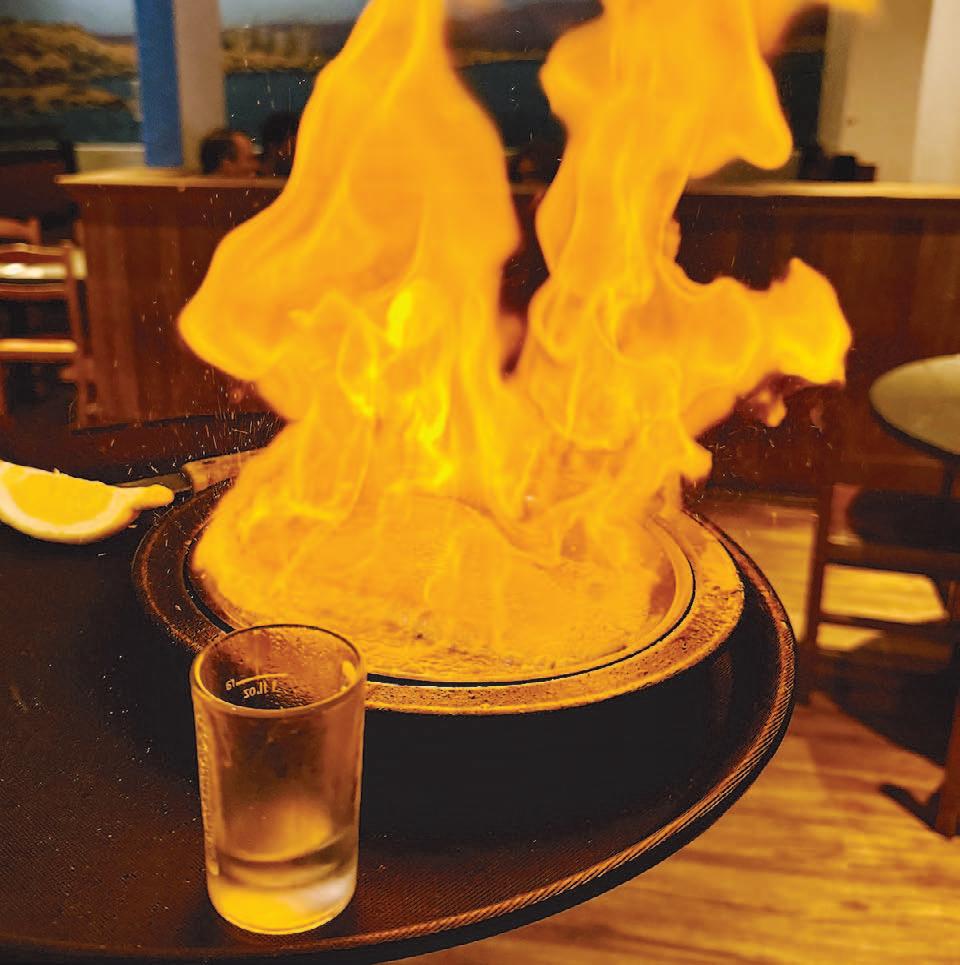
Rex Café grew into a lasting legacy. Each year, Papa Pete would invite employees and their families to his home for Christmas dinner, along with a few customers they knew would be alone that day.
These Christmas dinners quickly outgrew their home. Rather than give up the cherished tradition, they moved the event to the restaurant, where anyone who needed a meal on Christmas Day was welcome to come at no cost. This single charitable event drew as many as 2,200 people to share a meal of turkey, ham, and prime rib—with all the fixings plus dessert. The Stamos family even expanded the tradition to include meals for shut-ins.
According to Steve, pulling off


such an event takes more than just a lot of food. More than 100 volunteers share part of their Christmas to help prepare and serve meals. What touches him most is that the list to volunteer opens on December 1st each year and is filled by the 10th. It says a lot about the people who live here.
This generous support has shown up in other times, too. Steve recalls, “During COVID, like all restaurants, we were closed to inside dining. But we stayed open for take-out orders. What we witnessed was incredible— people not just from Kalamazoo and Portage, but from miles away, ordered take-out to support the Blue Dolphin and its staff. Many added generous tips for our employees.” That kindness and loyalty weren’t lost on Steve and his team. It only reinforced something they long appreciated—how wonderful it is to be part of this great nation.
The 80th anniversary of the Stamos family restaurant legacy is more than a well-earned milestone for a great restaurant. It is a meaningful acknowledgment of everything great about America and the American dream. People like young Gus Stamatelos (later shortened to Stamos) sought an opportunity for life, liberty, and the pursuit of happiness. In turn, he and his family have made America a better place as well.
James D. Coppinger



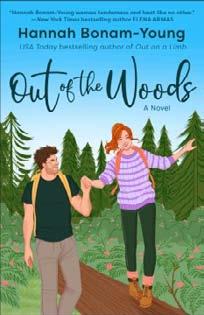
Out of the W Out of Woods: A No oods: Novveel l Hannah Bonam-Young (Dell)
In this follow-up to Out on a Limb, high school sweethearts Sarah and Caleb find that over a decade into marriage, their relationship has changed. They resolve to rekindle things through a weeklong couples retreat, camping in the wilderness. This second-chance romance features flashbacks and great character backstories that elevate it from the typical trope
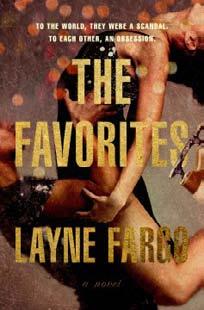
T The F he Favavorites: A No orites: Novveel l Layne Fargo (Random House)
This novel looks at ambition and the elite figure skating world with a sharp eye and a fierce writing style. It's a dishy story of an Olympic icedancing couple with some truly romantic moments, the pacing of a thriller, and a documentary interview style that effectively propels the story along.


Three friends reunite in the Hamptons only to have chaos ensue after a night spent out drinking. The fastmoving narrative features multiple narrators and lots of unexpected twists Burke has delivered another excellent psychological thriller
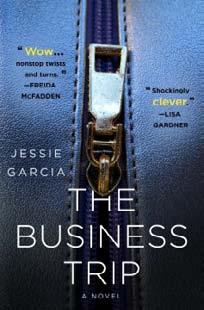
Stephanie, heading to a work conference, meets Jasmine, who is running from an abusive relationship. They find themselves connected to Trent a raging narcissist. When both women turn up missing, evidence is found at Trent's house. This fast-paced plot will keep readers guessing until the very last page of the book.

the trauma of her brother's death. Through a treasured heirloom pottery jar, the novel chronicles the history of Ebby's family and its
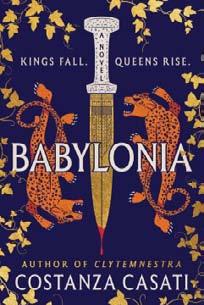
Semiramis was abandoned by a fragile mother and raised by a cruel stepfather
She grows up learning that to belong in a maledominated society, she has to think and fight like a man. The author's research, vivid descriptions, and memorable characters make for a great read.

This delightfully madcap adventure through dangerous jungles and beautifully realized relationships will appeal to fans of Segura's first romance, but can be read on its own. Perfect for patrons who are looking for the quirky banter of India Holton or the academic wit of Ali Hazelwood.






T The In-Betw he In-Between Bookstor een Bookstore e Edward Underhill (Avon)
In this aching “what if ?” story, Darby goes back to his Midwest hometown and finds everything has changed but the In Between Bookstore—in fact, when he walks in, the person behind the counter is the sixteen-year-old version of himself. A tender look at how events change and create us— and how not even the closest people to us can know what’s going on in our heads



T Teelll Me What Y l What You Did ou Did Carter Wilson (Poisoned Pen Press) Poe, a popular true-crime podcaster, has the tables turned on her when a caller claims to know her past. Poe took out her mother's killer years ago, but the caller says




Oh, the crackle and warmth of a fire in the wood stove in chilly February! My wood stove is one of my favorite features of my hundredyear-old little red farmhouse. I fear no winter power outage. Yet there are other ways of bringing warmth and comfort to our homes in winter.
A wood-burning fire emanates a wonderful scent of wood to the room. Add a bowl or basket of cinnamonscented pinecones scattered over pine needles to bring wintry perfumes to the air. Better than any chemicalemitting fragrance, guaranteed, and safer.
When curling up on your couch with a good book—surely one of the most enjoyable things to do on a snow day—wrap yourself in a colorful afghan or throw and soothe your back on a selection of bright pillows. Not only will they make you toasty warm as you immerse yourself in the storyline, but the vibrant colors will cheer your eye when the skies are overcast and sunshine reluctant to brighten your room.
Last chapter read, gather the family for a movie. Winter can be the best time to catch up on those awardwinning films that have gathered all



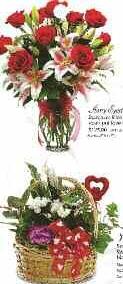



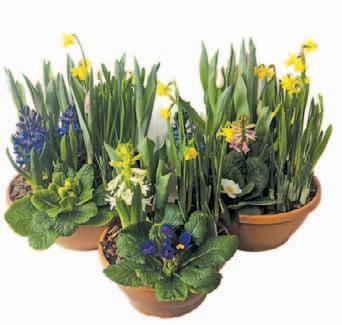
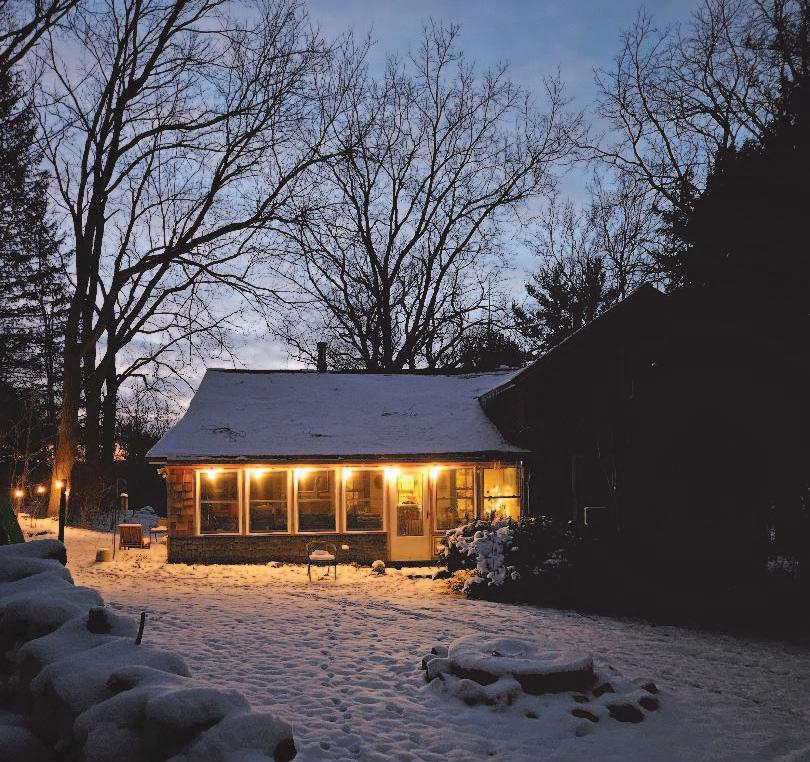
those Golden Globes and Oscars. Dare I recommend the awardwinning animated film FLOW by
director Gints Zilbalodis? It is suitable for all ages, without dia-






logue, following the story of a black cat navigating a flood with its animal companions in a fragile environment. Pass the buttered popcorn and discuss once the movie is over for more family bonding.
Winter isn’t entirely about relaxation, however. Just because the outdoors is bone-chilling doesn’t mean the work is done. This is a season that can be perfect for catching up on chores, both indoors and out. Once that book is read, consider donating it to the library. And while you are at it, sort through your bookshelves for other titles you have already read or, let’s admit it, never will. Add to the donation pile. Make space for exciting new titles.









Move on to those crowded and messy closets. Thrift stores are the thing now as people realize what level of damage accrues from fast fashion filling landfills. If you don’t want that shirt anymore, or it no longer fits (holiday treats were SO delicious!), someone else may love it and give it new life.
On a snowy weekend when the roads are scary, make it a day of cooking. Create freezer meals and stack your freezer full for quick and easy meals during the work week. Pull in the family to help chop and dice and pack.
When is the last time you rotated your mattress? Do it. Move that dip on the right to the left, even out the ditch in the middle. Rotating and flipping your mattress can add years of use to its life while staying firm for your back.
Don’t forget the bathroom. Windows are closed on winter days, so ventilation is reduced. That can lead to mold and mildew growing between tiles and grout. Roll up your sleeves to give the in-betweens and the nooks and corners a good scrub. Then take a hot bubble bath and enjoy.
With all that done, don’t forget to play. Who wants to go sledding? A snowball fight! A row of snowmen and snowwomen and snowchildren and snowdogs and snowcats in the front yard is much more fun than those stickers in your car’s rear window to mark your family members. Then pull out the board games and gather the family for a hot mug of cocoa, yum.
Zinta Aistars


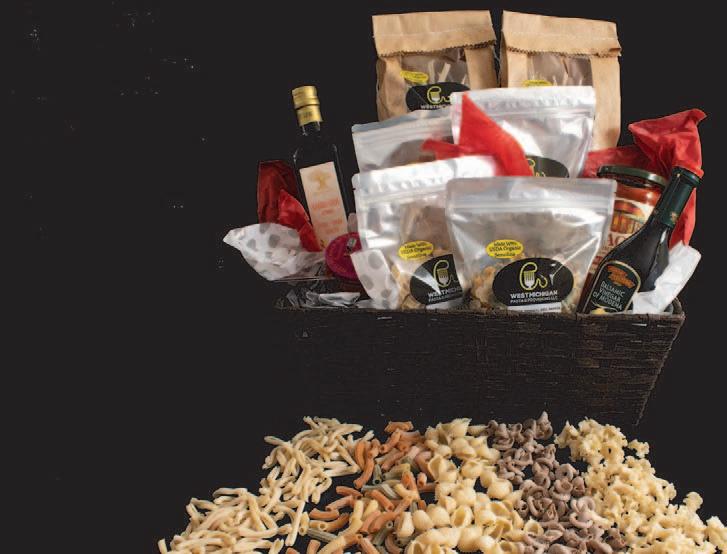

“Connection is why we’re here. We are hardwired to connect with others. It’s what gives purpose and meaning to our lives” - Brene Brown Recently I had reason to contact customer service at a company in California. Though a dramatic word for a minor issue in the scheme of things, I share that I felt desperate to receive assistance from a live voice. I had been trying multiple times to obtain answers from UPS, only to find myself tossed like a pin ball without the joy of racking up game points in the designed to be efficient virtual chat and automated voice systems. In that magical miraculous way that life works, I was led to the customer care person to affirm a wish I have as we begin our quarter century. That we don’t turn away from an innateness in us all that flourishes best
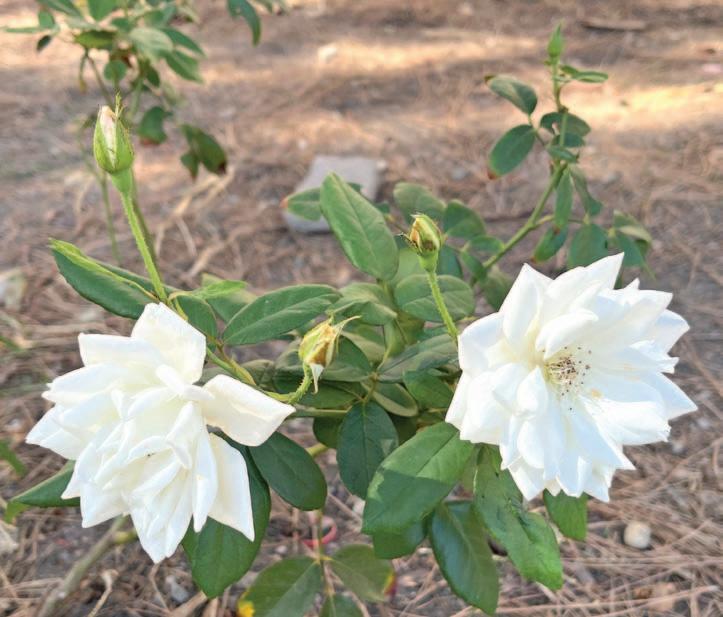
when connecting human being to human being.
I was calling this customer care individual on the day I had assisted my mom in checking in online for an inperson appointment she had the following day. Forty-five minutes later after a lengthy username / password set-up process, multiple information requests across several screens, and two forms to read and electronically sign, my mom was checked in. To say dehumanized process would be an understatement!
Fast forward to the voice on the other end of the line responding with kind attentiveness, despite the fact that I was not her first needy call. Granted, I, too, had ownership in how I was choosing to be present on the call. My approach was to acknowledge that I knew she was not
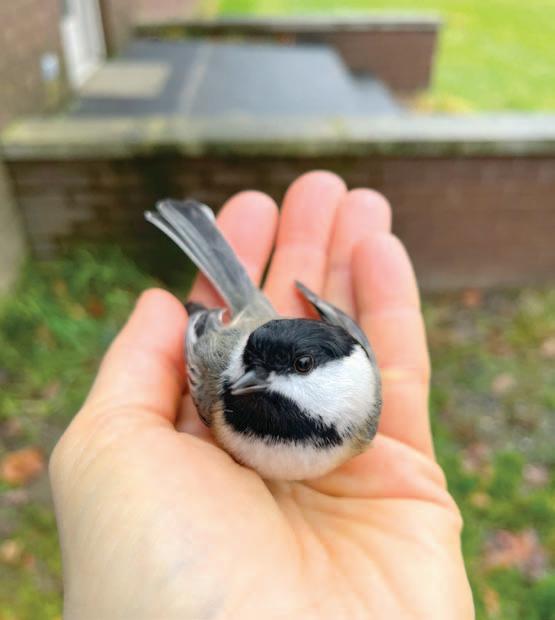
the culprit in the shipping debacle that was happening; vulnerability and humbleness play significant roles in our ability to connect.
As I shared my frustration, she showed up authentically, without rehearsed responses, listening without interruption, and, at the right time, displaying empathy to me by sharing others and her experiences that affirmed she understood and that I was not alone in those feelings. Her sharing was not only offering me that basic need we all have – to be seen and heard. She also provided me hopefulness that I was being helped and would no longer be pinging against pinball flappers in a virtual system with an automated voice who was simulating customer care minus sincerity and absent the resolution.
By the end of our eleven-minute
call, this individual and I were talking about her two sons, how I didn’t think her voice sounded old enough to have sons in their twenties, and how she wished for health care systems to be more user friendly for her mother, too. As we both connected human being to human being, I ended the call expressing to her not to lose her radiant light as a way shower.
As she shared that her eyes were now filled with tears, touching my heart in turn,, we both hung up determined the meaningfulness of human connection would not end with us.
Christine Hassing https://christinehassing.com






Two new restaurants that opened locally in late 2024 have tasty food and beverages that are already drawing customers. And although both restaurants have new ownership, they’re based in long-established buildings that have been favorite spots for years.
In south Portage, Kalako Pizza opened on December 11 in the building at 10240 Portage Road, near Osterhout Road, that was home to Chicago Style Pizza for 44 years. New owner and head chef Kody Asakevich says Kalako will continue to offer delicious pizza—and much more—at reasonable prices.
“Some of our big items are sandwiches, burgers, wings, and meatballs,” says Asakevich. “We have a number of appetizers and plan to expand the selection in the summer.” Kalako Pizza also has a selection of desserts, including tiramisu, brownies, and strawberry shortcake. Kody and his fellow chefs arrive hours before the daily opening in order to make 200 lbs. of pizza dough and prepare 150 lbs. of cheese for customer orders.
They proudly say that everything is made from scratch, and customers seem to appreciate the care taken in the ingredient selection and preparation. Asakevich says that from Day One, customer support has been
enthusiastic from new customers as well as those who patronized Chicago Style Pizza. He says that Kalako’s pizza borrows the best elements from both New York and Chicago-style pizzas depending on thickness.
A long-time resident of Portage, Asakevich has a Culinary Arts degree, and he remembers loving the pizza at Chicago Style, his “favorite restaurant as a kid.” He’s glad that he and his wife, Leah, found the opportunity to own the new business and to continue providing customers with good food.
About 25 miles to the north, at 107 S. Main St. in downtown Plainwell, 1871 Taproom opened on October 10 at a spot that’s been around even

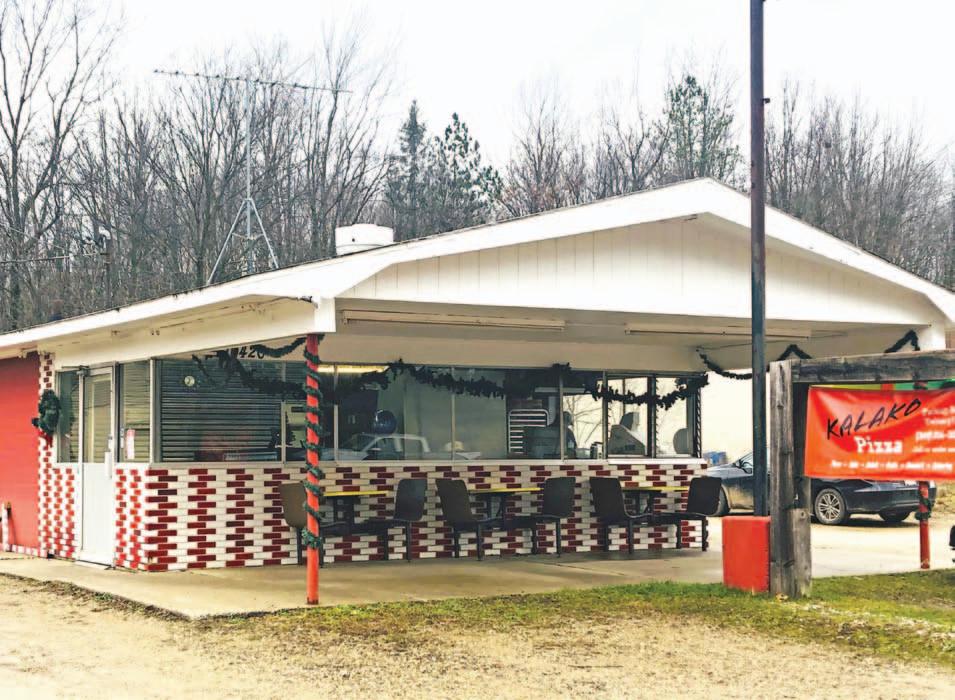
longer. The “1871” in the establishment’s name reflects the year the building was constructed. However, food choices are up-to-date to meet customer tastes.
John Stuart, who co-owns 1871 Taproom with his brother, Tim, says customer favorites include the smashburger, fried perch, and handdipped onion rings. The restaurant also has an extensive menu of sandwiches, wraps, baskets, salads, soups, and desserts. They also have an impressive list of beverages including beer, wine, and mixed drinks.
Owning and managing a restaurant is a new endeavor for Stuart, who spent 30 years in the banking industry before deciding to own a commu-
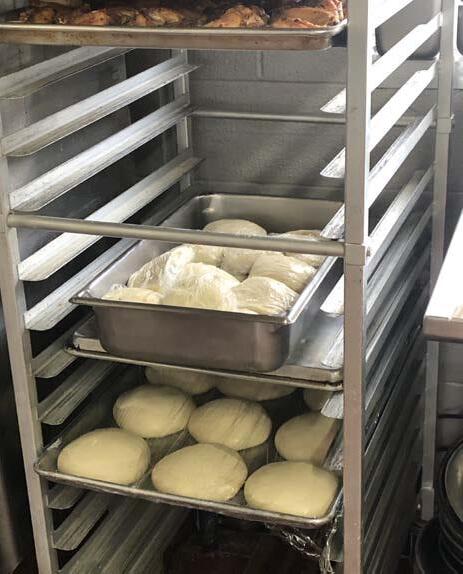
nity restaurant.
“I wanted to try something completely different, a different opportunity,” says Stuart about his inspiration to acquire and operate the restaurant. He adds that customer reaction has been great since opening: “The local community has really turned out to support us,” looking for new things to eat as well as established favorites.
Stuart says the previous restaurants that occupied the building have been anchors of downtown Plainwell for years, and the new restaurant honors the previous businesses by listing their names on its menus. 1871 Taproom was previously Mayor’s Joint, and before that, Rhino’s Hometown Pub, with additional taverns and pubs listed back to 1948.
In addition to food and drink, 1871 Taproom offers entertainment for customers, especially live music and karaoke. Events, as well as special dishes, are listed on their Facebook page, which is very active and updated frequently by Stuart’s wife, Michelle.
The new management at both Kalako Pizza and 1871 Taproom are enthusiastic in serving new customers.
Tony Ettwein HistoryZoo1837@gmail.com

Family dynamics play a crucial role in shaping our mental health and overall well-being. The closer and more supportive our family ties, the more likely we are to enjoy a healthier, happier life. According to Psychology Today, strong family bonds lead to reduced stress levels, lower depression rates, and enhanced longevity.
The interactions we have with our family members are pivotal in cultivating either healthy or complicated dynamics. Today’s families come in all shapes and sizes—singleparent households, blended families, nuclear families, and more. Each family navigates its unique path, and there’s no one-size-fits-all approach to functioning as a family unit. While some dynamics thrive, others can be unhealthy or dysfunctional. If you sense that your family dynamic leans towards the dysfunctional side, remember that it’s possible to reshape those interactions for a more positive atmosphere. Even families that seem healthy should regularly assess how they can enhance their relationships.
Interesting family arrangements exist too. For example, in some cases, grandparents take on the role of primary caregivers, while others choose

not to have children at all. And let’s not forget about “chosen families”— longtime friends who become as close as or closer than blood relatives. In functional families, members create a nurturing environment where everyone feels listened to and respected. Open communication flourishes, and emotions can be expressed without fear. Boundaries are respected, and positive reinforcement is a way of life.
On the flip side, dysfunctional
families often struggle with overwhelming negative emotions. Tension and anger can become contagious, infecting the entire household with stress. Growing up in a home where emotions are stifled makes it challenging for adults to establish healthy self-regulation and boundaries, often resulting in a cycle of chaos and misunderstandings. In these circumstances, family members might face constant arguments, hold grudges, or even cut off communica-
tion altogether. The absence of unity and empathy can chip away at selfesteem, potentially leading to higher risks of depression and anxiety. This chaotic environment stifles emotional expression, leaving individuals feeling guarded and judged without accountability.
If your family is caught in dysfunctional patterns, remember that therapy can be a transformative step toward healing. Seeking help from a professional can guide you in redesigning family dynamics for a brighter future. You can find a therapist through Psychology Today—just enter your zip code and take the first step toward restoring harmony in your family. Your journey to healing starts here! Family dynamics play a crucial role in shaping our mental health and overall well-being. The closer and more supportive our family ties, the more likely we are to enjoy a healthier, happier life. According to Psychology Today, strong family bonds lead to reduced stress levels, lower depression rates, and enhanced longevity.
Dr. Julie Sorenson, DMFT, MA, LPC







As parents, we all want the best for our children—happy, healthy, and ready to take on the world. But what if the secret to their growth and development lies in something as simple as play? Whether it’s building block towers, running around the yard, or diving into a make-believe world, play isn’t just a way to pass the time. It’s how kids learn, grow, and discover who they are. So, let’s dive into the world of play and see why those giggles and games are more important than you might think.
Play is essential for physical, cognitive, social, and emotional development. It helps children explore the world, develop problem-solving skills, and practice decision-making in a low-stakes environment. It helps in developing identity, social skills, creativity, while also aiding in lowering stress and promoting resiliency. Play is vital for one’s welfare at any age,
but it is critical during the core developmental years of birth to 5 years old as it lays the foundation for the developmental process that supports our wellbeing throughout life. During early infancy, from birth until 3 months old, babies begin the process of learning to play. This stage is called unoccupied play and looks like random physical movements matched with the beginning awareness that the one can make their body move. This stage is followed by solitary play up to the age of 2 years old. During this stage, little ones are mastering the basics of playing with objects such as their bodies and simple toys continuing to build the awareness of mind and body connection and simple cause and effect. Once they start to find some mastery in solitary play, they move into spectating as they notice others play too. As this curiosity continues to
develop, toddlers at about the age of 2 years begin the process of parallel play, playing side by side but not necessarily with others. From 3 to 4 years old children engage in associative play, while they will play the same thing as their peer, they are not yet able to work together. One example of associative play would be playing house while one child cooks and the other takes care of a baby. About the age of 4 to 5 years, children start to work on developing cooperative play working together to co create the experience, achieving a common goal while taking on different roles.
As parents, it’s easy to get caught up in schedules, milestones, and the hustle of daily life. But in the moments when your child is lost in play—whether they’re stacking blocks, pretending to be a superhero, or running around with friends— they’re doing something extraordi-
nary. Through play, they’re building the skills, confidence, and creativity they’ll carry into adulthood.
So, next time you see your child at play, take a moment to appreciate the magic happening before your eyes. Encourage it, join in when you can, and know that these moments of joy and discovery are laying the groundwork for a brighter future. Play isn’t just child’s play—it’s the key to unlocking their full potential. If you have concerns about your child’s play development, please reach out to your local play therapist for support on assessing and addressing any underlying concerns.
Christina Thomason, LMSW Acacia: A Place for Personal & Family Development




Offering an aroma and taste that’s reminiscent of the hearty 1950s, cooking with Cornish hens adds an old-fashioned chicken flavor that helps any recipe you add it to take flight!
Photographer: Laura Kurella
They say that necessity is the mother of invention and there is perhaps not a single cook out there that has not found themselves in a situation where they have needed to substitute an ingredient to make due. Flying by the seat of our pants, as Mom used to say, I have come to learn that improvising with ingredients can sometimes and unknowingly prove to be a catalyst that leads to better tasting meals. Such was the case when I began craving Mom’s homemade chicken vegetable soup. Triggering a quick trip to the local market, as I was gliding down the aisles gathering ingredients my eyes couldn’t help but spy a sign that read, “Cornish Hens $1.99 each.”
“Hmmm,” I thought to myself, “How different could Cornish be from a regular hen?” Deciding to wing it, a Cornish hen suddenly found itself roosting in the baby seat
of my shopping cart.
The next day I could tell there was something different about the soup the moment the pot began to simmer because the aroma seemed more intense. More earthy and meatier. So much so that it was literally making my mouth-water.
“My goodness!” I reflexively sighed. “This soup smells just like Mom’s did when I was a kid!”
Feeling cradled in the comfort of its warm and inviting aroma that swaddled the entire room, the joy of eating the soup was just as comforting too, because it magically caused all my adult stresses to momentarily fly the coop. “Ah!”
Amazed at what a difference a Cornish hen could make, I had to investigate them. Learning that Cornish hens were developed for commercial sales in the 1950s, unlike other poultry, Cornish hen breeding hasn’t changed much since.
Created by crossing a standard Cornish chicken with a White Plymouth Rock hen, and a Malayan fighting cock, Rock Cornish game hens mature quickly and develop particularly large breasts and fatty skin. This appears to be what gives them extra flavor potential, and when combined with its young age and petite size, gives Cornish hens a unique flavor and texture profile that bigger, older
Approximate servings per recipe: 4.
1 to 2 tablespoons favorite cooking fat
1 Cornish hen
1 yellow onion, chopped
2 celery stalks, chopped
3 cloves garlic, minced
1 teaspoon red pepper flakes (optional)
unrefined (colored) sea salt and pepper, to taste
1 quart chicken bone broth
Juice of 1/2 lemon
1 (14-oz) can baby artichoke hearts, drained and quartered
1 cup shredded mozzarella
1 cup finely-shredded Parmesan
2 tablespoons heavy cream (optional)
1 (10 oz. box) frozen spinach, thawed, rinsed, well drained
1 teaspoon parsley flakes
In a soup pot over medium heat, add
fat and chicken. Cook for 3 minutes then add onion and celery. Cook, turning chicken until onions start to brown, about 8 minutes. Add garlic, and red pepper, (if using). Cook for one minute, then add broth and lemon juice and bring to a boil. Lower heat to a simmer, cover and cook, occasionally rotating chicken, for 30 minutes.
Remove chicken from the pot then using forks, clean then shred chicken meat. Place shredded chicken in the pot, discard or reserve skin, bones, and other solids for another use.
To pot add artichoke hearts, mozzarella, Parmesan, and cream, (if using). Cook over low heat, stirring, just until all the cheeses melt. Stir in spinach and serve garnished with parsley and more Parmesan, if desired.
chickens don’t possess.
Offering a delicate, sweet chicken flavor, and tender, fall-off-the-bone meat that practically melts in your mouth, it’s hard to go wrong with a Cornish hen. That said, I have learned (the hard way) that it is best to avoid Cornish hens sourced from any poultry giant as they sadly don’t offer the flavor punch that smaller, less familiar brands have. When shopping, look for lesser-known brands, or even local if you can.
Mom was particular about how to serve and store soup. She would always debone and skin the chicken, placing the meat into its own storage bowl. She’d also make egg noodles, usually wide, and then rinse them in cold water, so they wouldn’t stick to each other, then place them in a bowl of their own, too.
She’d hand us our bowls and let us decide how much meat and noodles to add, then she’d ladle hot soup in, giving us as much as we wanted.
Mom kept the meat and noodles separate from the soup because she said that putting them in causes them to degrade in an unappealing way.
When Mom froze soup, she did not put any noodles in it because they would degrade and cloud the soup, but she did add in the chicken because the soup protected the meat from freezer damage.
Whenever Mom roasted chicken, Cornish or otherwise, she’d always use an enamel roasting pan because she said they roast chicken best. This type of pan remains economical to this day, and is super-easy to find in local thrift stores, too!
FYI: The best way to clean them is baking soda, and for stubborn stains original Barkeepers Friend and a scrubbing pad will get them back to their original, sparkling clean! Here now are some warming winter ways to wrap yourself in all the comforts of childhood by “winging” it with a Cornish hen. Enjoy!
Laura Kurella is an award-winning home cook who loves to share recipes from her Michigan kitchen. She welcomes comments at laurakurella@ yahoo.com.
Laura Kurella
1. Thaw in the refrigerator overnight before cooking.
2. After cooking, tent with foil and let rest for 10 minutes before serving.
3. For crispy skin, apply butter, oil, or a glaze to the skin, basting every 15 minutes or so while roasting.

Approximate servings per recipe: 8.
1 tablespoon of your favorite fat
1 large carrot (1 cup) finely chopped
2 stalks celery (1 cup) finely chopped
4 green onions (1 cup) finely chopped
2 garlic cloves, finely chopped
2 quarts low-sodium chicken bone broth
2 bay leaves
1 cup arborio (risotto) rice unrefined (colored) sea salt and black pepper, to taste
1 pre-roasted Cornish hen (or a store-broasted chicken)*
1/2 cup fresh lemon juice (3 lemons warmed)
2 large eggs
Fresh parsley for garnish (optional)
*= Save the skin and bones for making stock!
In a large Dutch oven or heavy pot, heat 1 tablespoon of fat over medium-high heat. Add the carrots, celery, and green onions, toss briefly, then stir in the garlic. Add rice, stirring, and cook for 3 minutes, then add the chicken broth and bay leaf. Raise heat to high, then season with salt and
pepper to taste.
Once mixture comes to a boil, reduce heat to low, cover, then simmer for 20 minutes or until the rice becomes tender. While rice cooks, skin, bone, and shred chicken meat. Place shredded meat in a bowl on the stove to hold warm.
Once rice cooks, in a medium (preferably metal or glass) bowl, whisk together the lemon juice and eggs. While whisking egg/lemon mixture, slowly add 2 ladles full of the hot rice soup to them. Whisk well to temper
the egg. Add the shredded chicken to the soup pot, and cook just until heated through. Add egg/lemon mixture to soup pot, stir in then remove from heat immediately to prevent egg from separating. Garnish with fresh parsley, (if desired), and serve hot with your favorite bread.
Note: You can use 1 cup orzo in place of rice, but since orzo cooks more quickly, cooking time will drop to about 7 minutes.

Approximate servings per recipe: 4.
4 Cornish game hens unrefined (colored) sea salt and pepper, to taste
1 lemon, quartered
4 sprigs fresh rosemary
3 tablespoons olive oil, divided use 24 cloves garlic
1 yellow onion, quartered
1/3 cup white wine
1/3 cup low-sodium chicken bone broth
4 sprigs fresh rosemary, for garnish
Preheat the oven to 450 degrees. Rub hens with 1 tablespoon of the olive oil. Lightly season hens with salt and pepper then place 1 lemon wedge and 1 sprig rosemary in the cavity of each hen. Arrange in a large, heavy roasting pan, and arrange garlic cloves and onions around hens. Roast in a
preheated oven for 25 minutes. Reduce oven temperature to 350 degrees. In a mixing bowl, whisk together wine, chicken broth, and remaining 2 tablespoons of oil; pour over hens. Continue roasting about 25 minutes longer, or until hens are golden brown and juices run clear. Baste with pan juices every 10 minutes.
Transfer hens to a platter, pouring any cavity juices into the roasting pan. Tent hens with aluminum foil to keep warm. Transfer pan juices and garlic cloves to a medium saucepan and boil until liquids reduce to a sauce consistency, about 6 minutes. Spoon sauce and garlic around hens. Garnish with rosemary sprigs, if desired, and serve.
Approximate servings per recipe: 8.
2 quarts low sodium chicken broth
2 to 3 Cornish Game Hens (or 1 whole fryer)
1 large sweet onion
1 turnip
2 small parsnips
6 ounce can tomato paste
6 leafy stalks celery hearts
1 bundle flat leaf Italian parsley
4 whole cloves
4 whole black peppercorns
2 bay leaves
2 small cloves garlic, peeled
1-pound carrots, peeled and cubed
3 Idaho russet potatoes, peeled and cubed
1/2 gram saffron
1 bag thin egg noodles
In a large stockpot, heat broth to boiling. Add chicken, onion, turnip, parsnips, celery, parsley, cloves, peppercorns, bay leaves, garlic. Bring to a boil and simmer for one hour. Remove from heat. Carefully remove all solids from the pan then strain the liquid.
Return strained liquid to pot and bring to a boil. Reduce to a simmer and add saffron and the cubed potatoes and carrots. Simmer for 20 minutes. Meanwhile, prepare the egg noodles according to package directions and clean chicken meat from bones, reserving meat. Discard/ reserve skin, bones, etc., for another use.
Finish straining remaining solids, pressing through a large strainer. Add strained liquid to the pot and discard strainer contents or reserve for other use. (Sometimes I puree the parsnip, turnip, onion, celery, and garlic and return it to the soup pot.)
Once the carrots and potatoes are tender, the soup is ready to serve. To serve, place some prepared noodles in the bottom of a soup bowl, add some pieces of chicken meat then ladle with soup and vegetables from the pot.


Valued for their durability and charm, antique stoneware crocks provide collectors and enthusiasts with a window into the history of utilitarian craftsmanship. First imported from Europe, stoneware gained popularity in the United States as cost and competition encouraged local production. By the first half of the19th century, potters from the Northeast and eastern Midwest were producing American stoneware vessels.
Varying in size from a few inches to a few feet across, most crocks were designed for lacto-fermentation and
food storage. Known for its hard, dense texture and waterproof properties, stoneware most often features a gray or brown salt glaze. Introduced into the U.S. after 1775, salt glazing occurs when handfuls of common salt are thrown into the kiln during the firing process. The clay silica reacts with the sodium to form a sodium silicate glaze.
Several prominent manufacturers contributed to the legacy of American stoneware. These include the Monmouth Pottery Company, recognized for its maple leaf logo,
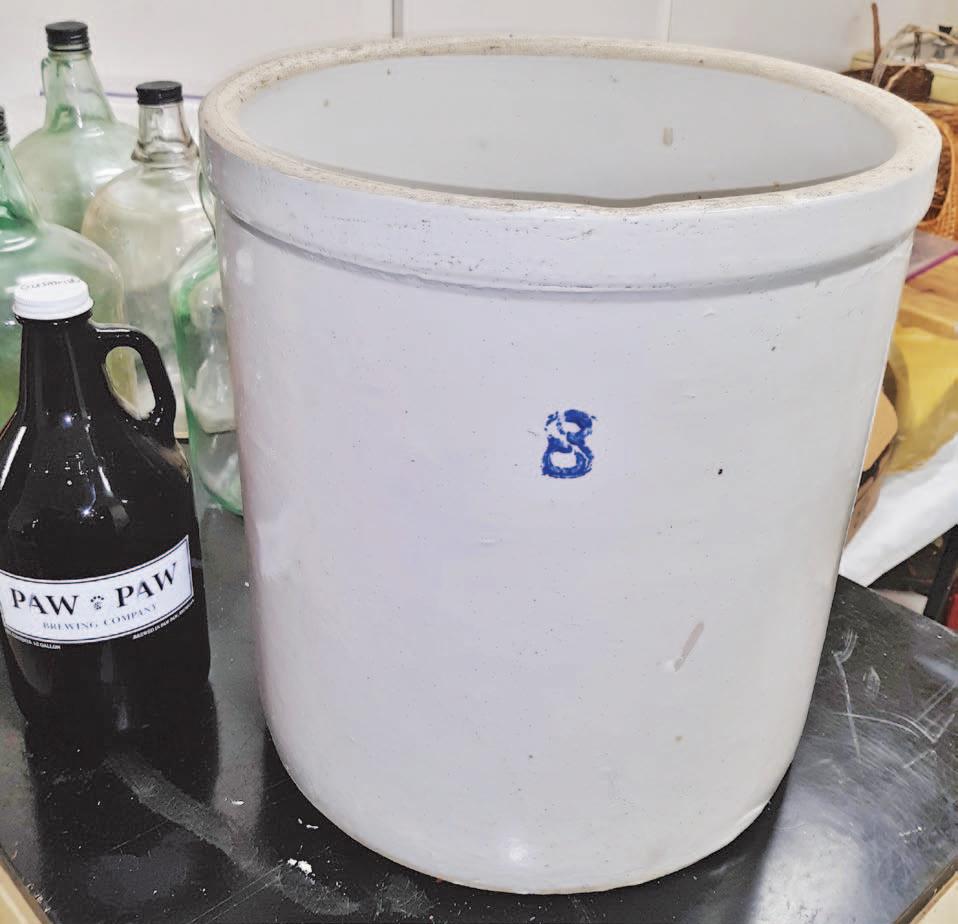

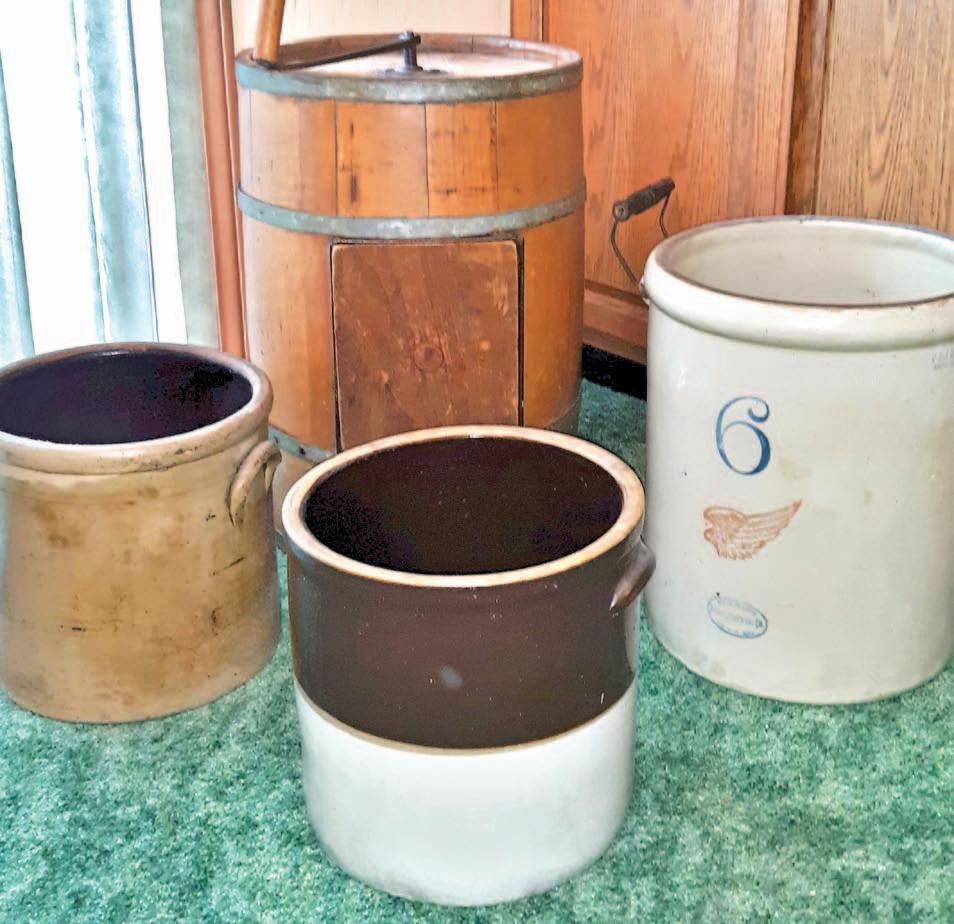
and Robinson Ransbottom Pottery, known for its cobalt blue crown mark. Red Wing Stoneware, which added the classic red wing motif in 1906, remains especially sought after.
When identifying antique stoneware crocks, several key features can help distinguish authentic pieces from modern reproductions. Start by inspecting maker’s marks, which are most often found on the bottom or sidewalls of a crock. Numbers will show the vessel’s capacity, representing its size in quarts or gallons.
Pay attention to decorative elements. Early crocks often featured hand-painted designs in cobalt blue. Motifs like flowers, birds, and butterflies were popular, particularly in Pennsylvania. These freehand designs applied before glazing, lend authenticity. Watch for the glassy, pebbled texture of the authentic salt glaze. The crock’s silhouette also provides clues. Cylindrical shapes became standard after 1860. Non-cylindrical crocks will likely predate this period. Smooth surfaces, stamped markings, or decorations painted over the glaze suggest a reproduction.
Factors like clay color, size, and intricacy of design can influence a crock’s value. Yellow or white clay might indicate specific makers, while detailed cobalt blue patterns often command higher prices. Chips, cracks, and wear can reduce value, though crazing may authenticate
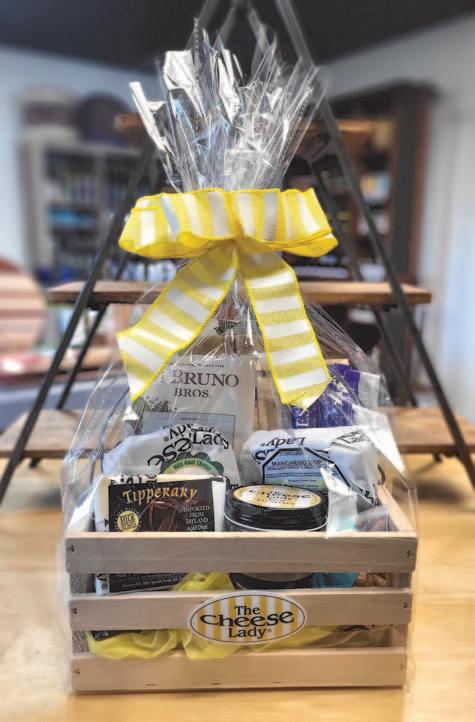
age. Original lids and intact handles also enhance worth. Larger crocks are generally rarer and more valuable. Provenance adds local appeal, often bringing higher prices in their area of origin.
While most antique crocks sell for under $100, exceptional pieces, such as an 1858 crock—sold for a record-breaking $1.56 million—can fetch much higher prices. Mid-19thcentury crocks with simple cobalt designs often sell for $500–$1,000, Detailed decorations can raise values to $10,000–$25,000.
An antique crock will look well in any home. Their variety of sizes gives them loads of versatility. Use them to store kitchen utensils, tools, or towels. They work beautifully as vases and planters. Even chipped crocks have charm and are budget-friendly. Hide those imperfections with greenery or display them proudly as an indication of history. These timeless pieces will supply utility and aesthetic appeal for decades to come.
Bridget Klusman Owner, Retro Estate Sales
https://retroestatesales.wixsite.com/retroestatesales
A. A Selection Of Vintage Crocks
B. Selection Of Antique Crocks With A 6-Gallon Red Wing
C. An 8-Gallon Crock
with

I’ve encountered people who boast about being great at multitasking, meaning that they pride in themselves about doing several things at one time. Media multitaskers claim they can seamlessly engage in numerous mental processes at the same time, such as reading emails while having a conversation on the telephone. Perhaps the demands of a work environment or of a parent prompts them try and do more and more within a limited amount of time. Picture the office worker shopping online while talking on the phone. Or how about eating and reading at the same time, something I find myself doing. It sounds like an ideal solution to managing the endless flow of information that comes with work and the daily barrage of media.
However, research shows that this strategy may not be as successful as it appears. The prevailing understanding of human cognition holds that the human brain can process only
one string of information at a time. It has found that high multitaskers are actually spreading their attention over a large scope of information and switching their attention back and forth between tasks. This is supported by studies using findings from MRI’s that highlight increased activity of the brain in specific regions while switching between tasks. These images showed that the act of jumping from task to task took a greater toll on brain power than focusing only on one task.
People once thought that high multitaskers might be able to retain more information in working memory than most people. However, subsequent studies showed that heavy media multitaskers performed worse on tests of working memory even in the absence of external distractions. These deficits in working memory ultimately led to problems encoding information into long-term memory, meaning they couldn’t remember things specific to the test a week or

two later.
Particularly striking is the effect that driving and talking on a cellphone (a form of multitasking) has on driving ability. Using a driving simulator, researchers found that drivers talking on a cellphone, even a hands-free device, were slower to step on the brakes and were involved in more simulated traffic crashes than intoxicated drivers.
Ultimately, habitual multitaskers appear to have trouble navigating among multiple threads of information. Therefore, they are less able to screen out distractions to focus on the material that’s relevant to their goal. So those who claim to be good at multitasking are deceiving themselves into believing they’re skilled at processing multiple sources of information simultaneously when they’re doing just the opposite. And when it comes to driving a car, it could end in
disaster.
This information came from a Harvard Special Health Report on Improving Concentration and Focus. I purchased it to see if there would be information on helping me be a little less absent minded, especially putting things down (like car keys) and forgetting where I put them. I found it to be informative. There are several good tips which I’ll be sharing with you throughout the year. But for now, some insight into multitasking is a good start.
Remember to be kind, keep your fluids up and make every day great! Still keeping those resolutions?
Till next time,
Ken Dettloff ACE
Certified Personal and Brain Health Trainer












Meet Dr. Julie Sorenson, DMFT, MA, LPC—a passionate advocate for mental health and the founder of A Fresh New Start Counseling LLC, established in 2014. With years of experience spanning various realms of the mental health field, she has dedicated her recent efforts to The Teletherapy Group, combining expertise with compassion.
Dr. Sorenson has authored several insightful books, but her latest release is making waves: a captivating twopart set focused on suicide prevention. The first book, Let the Sunshine In From the Black Hole, is specially crafted for children in grades 3 to 5. Through the innovative use of personification, it helps kids navigate the heavy topic of suicide prevention in a way that’s relatable and understandable. This important resource can be a life-changer for schools, therapists, doctors’ offices, hospitals, and for parents or caregivers of children who may be struggling with thoughts of self-harm.
But that’s just one part of Dr. Sorenson’s powerful initiative! The second component, The Teacher Component for Suicide Prevention, equips educators with essential knowledge. It covers the history of suicide, current trends, and crucial warning signs. Training scripts guide
teachers on how to have sensitive conversations with students who may be at risk. This resource also includes lesson plans tailored to the student book, along with family resources for those impacted by a child’s struggles. With a background rooted in suicide prevention—having focused on this critical issue during her doctoral dissertation— Dr. Sorenson has become a trusted expert. Her commitment extends to training professionals across Southwest Michigan and contributing to legislative efforts for suicide prevention.

Dr. Julie Sorenson envisions these books as vital tools for communities worldwide, offering children the reassurance that they are not alone while providing school staff with the necessary knowledge to support their students. Remember, help is always available through the 988 Suicide and Crisis Lifeline.
Don’t miss out on these invaluable resources! Available on Amazon, you can purchase the books separately or together to enrich your educational library and potentially save a life. Let’s work together to create a brighter future for our youth!
Dr. Julie Sorenson, DMFT, MA, LPC










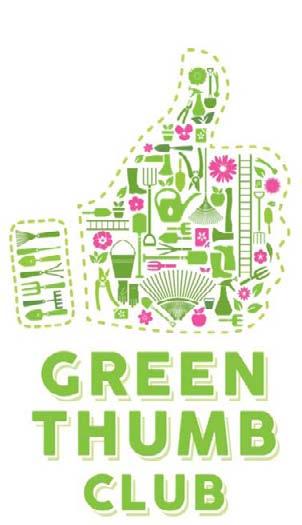













Several years ago, an artist friend told me about the Westminster Art Festival, so I headed to the Westminster Presbyterian Church on Helen Avenue in Portage to see the show. I’ve always been interested in my

community - what are local people thinking, making, concerned about, and how do they express their ideas through art and writing. After seeing the Westminster show, I came to the conclusion that there is an unbelievable amount of talent in our area! I enjoyed one of the best art and poetry festivals around IMHO.
When I’ve gone to the Westminster exhibits, I’ve turned into my gallery-nerd self and spent a lot of time studying each piece of art.
When I’m at an art show, I’m the person who stands transfixed, gazing at the art and losing track of time. I’ve even burned out a friend or two from ever going to an art show with me again - except for my artist friends who are almost as nerdy as I am about soaking up art and poetry. I like variety at an art exhibition. Instead of less is more, when it comes to looking at art exhibits, I like the old Victorian ideal of “more is more” instead. I think my love of seeing a large variety of art at a show started when I was a kid, and my mother took me to the Clothesline Art Shows in Bronson Park. Yes, the artists really did hang some of their work on clotheslines!
The color and variety inspired both my mother and me to become artists, and happily we both did just that.



The theme of the Westminster Art Festival always revolves around the stewardship of our environment. The 2025 theme is “One Planet.” All entered work needs to fit into this theme. You can read more about the theme on the Westminster Art Festival website. When I attended the 2024 exhibit, I was happy to see a large variety of different media artists used: Felting, wood working, paintings in oil, watercolor, tempera, and other painting media, fiber, sculpture, ceramics, dioramas, recycled and found objects, collage, accordion book art, and more. The festival includes a poetry competition. A beautiful catalog is created pairing each piece of art with lines from the poetry competition. The catalog is for sale at the awards ceremony and is a great keepsake.
Dust off your art supplies, gear up your inner poet, and get ready to enter this year’s festival. You can read more about it at Westminster Presbyterian Church or www. wpcportage.org The entry dates are: visual art March 31-April 7; poetry March 1-April 7, 2025; awards ceremony May 11. There are entry fees for submitting work. All 2D and 3D artwork must be hand-delivered to Westminster, no digital or USPS mail submissions
accepted. All poetry submissions can be e-mailed or USPS mailed. Admittance to view the exhibit is free and open to the public on certain hours and days from April 26-June 12, 2025. Make sure to check their website for the specific open hours before heading to the show. “The Westminster Art Festival is an annual independently juried presentation of visual art and poetry on an environmental theme, open to artists of any or no faith tradition.” ~ WPC website
I’m heading to my studio to get my submission ready to be judged for this year’s show. Please support your local artists and poets. Many of us create to entertain you, make you think, and share our thoughts with you. Maybe I’ll see you at the exhibit. I hope so.
“Ann Murray is an award-winning commercial illustrator and author. She has illustrated 8 children’s books and her stories have been in three published anthologies.”
A. “Our House” by Dawn Edwards. B. “I will Carry You” by Karen French.



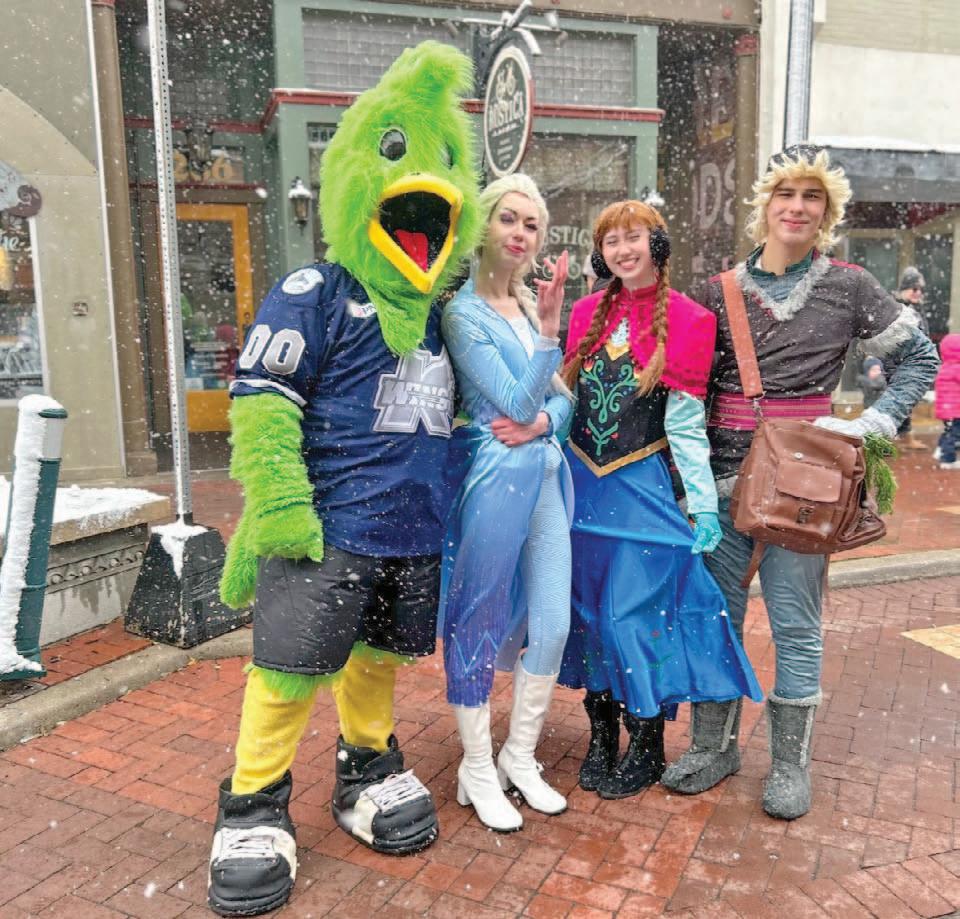
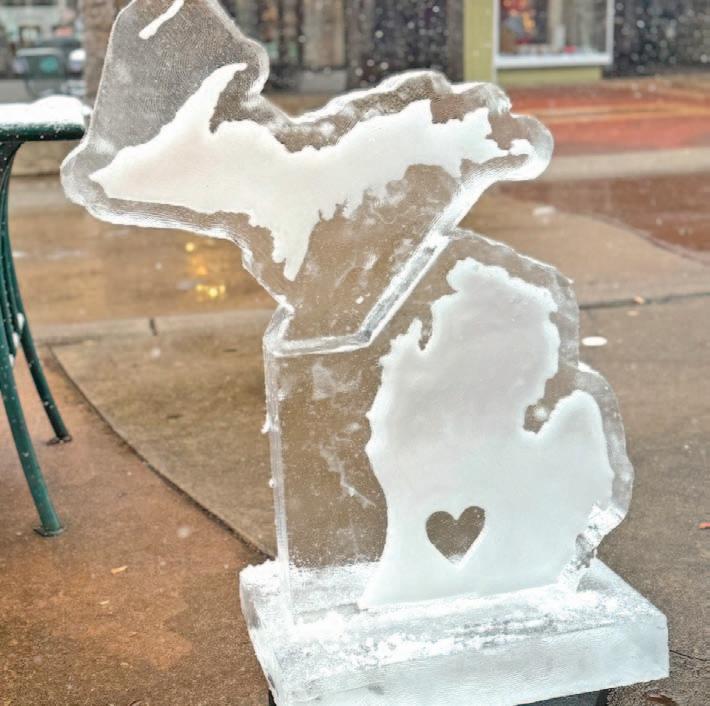

Bundle up and join us for the 2nd Annual Ice in the Zoo event on the Kalamazoo Mall! From 10am to 4pm on Saturday, February 15, the downtown streets will transform into a sparkling winter wonderland filled with stunning ice sculptures, community fun, and a frosty celebration like no other.
What to Expect:
• Beautiful ice sculptures crafted by talented artists.
• Meet & greet with familiar icy

characters—perfect for photo ops!
• Demos and fun with the Kalamazoo Curling Club, Husky Club, and Gull Lake Ice Club & more!
Stay warm with hot cocoa from your favorite downtown restaurants, pop into local shops to explore unique finds, and enjoy the festive winter vibes. It’s a great day to experience all that Downtown Kalamazoo has to offer!
Mark your calendars, bundle up, and join the fun. We’ll see you downtown!


I like watching the wintry winds swirl across the porch on these frigid mornings. There, I’ve said it! Of course, I’m safely tucked inside where it’s warm, hot coffee in hand, and snug in my pajamas and toasty robe!
I’m so grateful that I don’t have to venture out and even more thankful that I hired a service that will plow the driveway and shovel the sidewalks as needed. I am truly blessed.
Recently, I noticed that many of the perennials I so lovingly tended last summer have died back, cozy in their little underground beds, and are nowhere to be seen. That’s not much of a revelation – it’s what they should do. Annuals are supposed to die after completing their bloom and seeding cycle. That’s why they’re annuals. They set seeds and then die – leaving those seeds to carry the next generation. The perennials have shifted their biomass underground to storage stems and roots that will live in a metabolically dormant state until spring warmth signals the tissue to venture above ground and begin the cycle all over again.
What caught my eye recently was the plant life that remained green and seemingly healthy – even covered with snow and battered by harsh winds. Why don’t the hellebores drop their leaves? The arum and Pieris look almost as healthy as they did in August. Naturally, it set me to thinking, like any good biology teacher – even a retired one, about plant adaptations and how some plants can brave weather extremes that would kill more tender species.
For plants to survive the perils of a midwestern winter, they must overcome a variety of hazards. The most important prerequisite is for plants to enter a period of dormancy. Dormancy is signaled by a release of hormones in the fall, after the growing and seed-setting season. These messengers set into motion the series of events that lead to “hardening.” Hardening is the horticultural term for the preparation of a plant for the upcoming cold season. Many dormant plants will, generally, but not always, lose their foliage. As autumn days grow shorter, deciduous plants typically stop or greatly reduce photosynthetic activity. With diminished photosynthesis, leaf loss is a wise strategy. It reduces the amount of vulnerable tissue subject to harsh conditions. Sugars made through photosynthesis are usually converted to starches which are stored in root structures for use over the winter. If the plant has been successful over the growing season, receiving sufficient sunlight and nutrition, there should be adequate resources for the coming months of almost total metabolic inactivity. One phenomenon exhibited by some plant species is the production of actual proteins that serve as a sort of chemical antifreeze to prevent cell contents from freezing. A researcher at Michigan State University, referenced at the end of this article, has even found a gene that codes for such a protein, and there is considerable speculation that cloning those instructions into agricultural
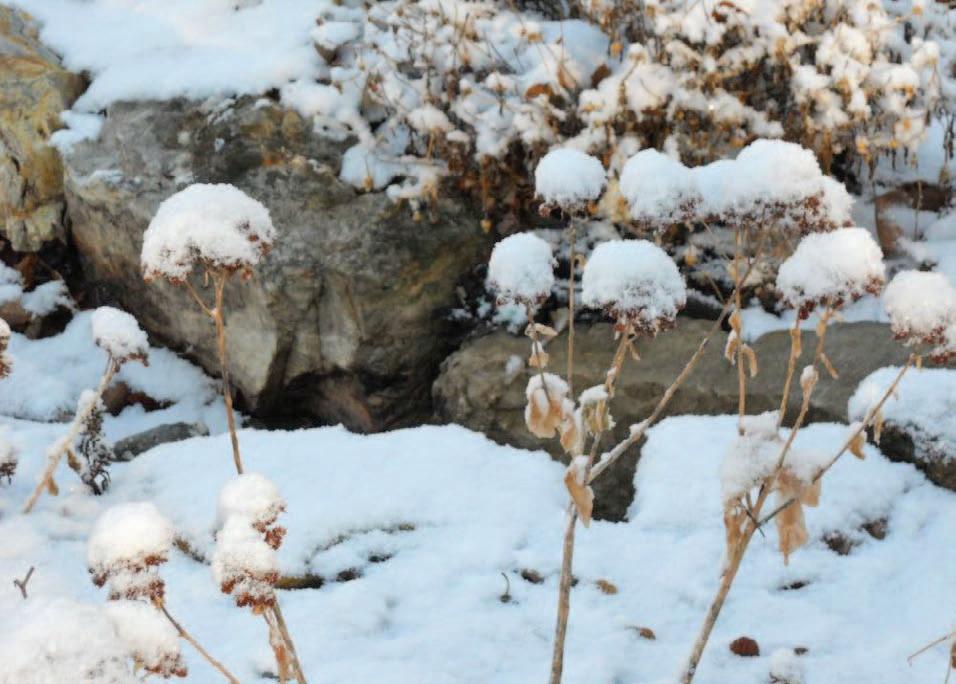
crops might make them less susceptible to extreme weather events.
Many evergreen species, whether low-growing plants, shrubs, or trees, utilize common adaptations to retain their foliage, while at the same time reducing the dangers of tissue destruction. Plant survival in winter requires cellular-level protection from the physical effects of the most abundant and necessary material that makes up all living tissues: water. Water is amazing! Such a tiny molecule should be a gas, but of course, it is a liquid at ambient, life-supporting temperatures – between 32° and 212°F. Its chemical structure allows water molecules to be attracted to each other, forming an intricate network that resists boiling and freezing under most weather circumstances. Water is frequently called the “universal solvent.” Most of the materials we need to “do life” – sugars, salts, even large biomolecules – are soluble in water. Too little water and plants wilt and die. Too much, and they droop and rot. The problem for plants in winter is that the intermolecular water network expands when it freezes, as is so likely to occur in Michigan winters. Ice is less dense than liquid water. (That’s why ice cubes float.) A neat trick – except that, inside a plant cell, that expansion will burst the cell wall and spill out the contents of the cell so that its viability is lost.
Here’s where the adaptations of some plant species are so remarkable. A common tactic, used by many cold-tolerant plants, occurs when they begin to move water molecules and solutes, like sugars and salts, out of the cell and into the surrounding liquid. These solutes disrupt the network of water molecules, making the process of freezing much
more difficult. The rearrangement of these water molecules disorders the molecular network of the ice crystal itself. In high school chemistry class, you might have learned about this phenomenon as “freezing point depression.” It’s the reason that we sprinkle salt on our roads and sidewalks. As rock salt dissolves onto the icy surface, the sodium or calcium ions disrupt its structure, making it more difficult for the ice to re-freeze. Actually, it’s not even necessary to use salt on roads at all. Sugar would work almost as well, albeit more expensively and with much more of a mess to clean up. Some parts of the state even spray sugar beet juice on the roads! In cold temperatures, the plant cell protects itself from ice damage by pumping some its internal water out of the cell into surrounding tissues, along with solute molecules that resist the re-freeze.
The cold of winter is an obvious peril, but dryness is equally dangerous. Ice is useless to plant metabolism and bitter winter winds dry plant foliage. Once cells have pumped out water to protect themselves from freezing, they are, by definition, dehydrated. This condition is critical to their survival, since it prevents freezing, but makes them vulnerable to further drying. It is critical for them to retain some water to sustain their minimal but necessary cellular functions. Plants that have evolved to routinely survive unforgiving winters have developed some ingenious physical adaptations to combat the problem. Paradoxically, some of these tricks are the same ones we see in other dry, harsh environments – like deserts! It might be helpful to think of winter as one long, cold desert season! One successful plant strategy
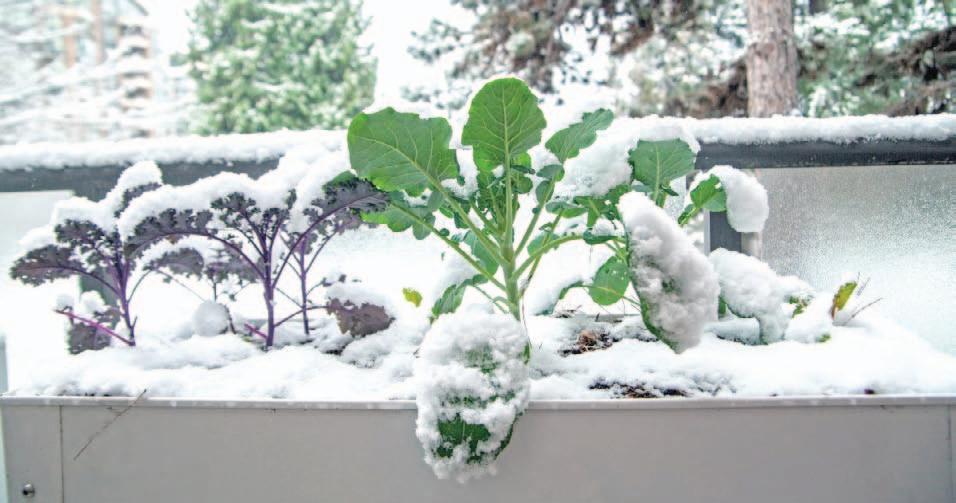
is a thick cuticle. A sturdy covering over the outer surfaces of a leaf (or needle, in some cases) prevents the loss of moisture from severe dehydration. Cactus leaves are well known to have tough surfaces that protect the inner tissues from water loss. My hellebore leaves have a large surface area but a thick, almost waxy covering that keeps them from being dried out by howling winds and from being water-logged if they lay in a puddle of melting snow.
Some plants, notably evergreen trees, are uniquely adapted for success in frigid northern forests. Their leaves are, to our thinking, not even leaves at all. We call them needles because of their thin, sharp exterior shape, which has evolved to provide minimal photosynthetic surface area while retaining the ability to conserve water. The dry, cold wind can travel right past, and very little precious water is lost to evaporation.
Just this week, I began receiving my first plant catalogs. It is a pleasure to look at the new possibilities for my garden. As you page through, take a moment to look at the hardiness requirements for your selections. According to the most recent maps, we are in Zone 6a. I am sure you will find examples of cultivars that use some of the adaptation strategies described in this article. Give them special consideration. They are uniquely suited to our changing climate conditions. They have been selected over many generations to ensure success in our tough Michigan winters. Happy spring dreaming!
Cheryl Hach
Retired Science Teacher
Kalamazoo Area Math and Science Center
References:
D’Augustino, T. (2022, November 10). Exploring your world: How plants cope with cold. MSU Extension. Retrieved January 01, 2025, from https://www.canr.msu.edu/ news/exploring-your-world-howplants-cope-with-cold
Wahle, E. (2021, January 1). How plants survive freezing temperatures. Illinois Extension - Welcome to My Jungle. Retrieved January 2, 2025, from https://extension.illinois. edu/blogs/welcome-my-jungle/202101-01-how-plants-survive-freezingtemperatures
American Association for the Advancement of Science (AAAS) (1998, April 2). Gene helps plants weather cold. Science.org. Retrieved January 2, 2025, from https://www. science.org/content/article/genehelps-plants-weather-cold
Michael, P. (2020, November 4). How plants survive the winter: Adaptations & damage. Green Bay Botanical Garden.org. Retrieved January 2, 2025, from https://www. gbbg.org/how-plants-survive-winter/
Through Sunday, Jan. 5, 2025 Exhibit: Secret Societies Illuminated In Kalamazoo, Kalamazoo Valley Museum
Saturday, Feb. 1 – Fri. Feb. 14 Adults, sign up for book recommendations and treats in A box, Vicksburg Library
Saturdays, Feb. 1,8,15,22 Live Music, The Dock @ Bayview, 8pm – 12am
Sundays, Feb.2,9,16,23 Portage Farmer’s Market 9am-1pm, Portage City Hall
Mondays, Feb. 3,10,17,24 Parchment Update Interviews Parchmentlibrary.org
Mondays, Feb. 3,10.17,24 Family Storytime, 10-10:45am Books, songs. Vicksburg Library
Mondays, Feb. 3,10,17,24 Jazz Night, 6-9pm Apoptosis Brewing Co., Kal.
Tuesdays, Feb. 4,11,18,25 Preschool Story Time, ages 3-5, 10:15, Richland Library
Tuesdays, Feb. 4,11,18,25 Drop in Gaming, 3-5pm Richland Library
Tuesday, February 4 Art Club for Adults, 6-7pm Pre-register, Richland Library
Tuesdays, Feb. 4,11,18,25 Trivia at Sit & Stay Winery, 68pm, 260 E. Michigan Ave., Kal.
Tuesdays, Feb. 4,11,18,25 Trivia @ 468 Wine, 6:30-8:30, 8842 Portage Rd., Portage
Tuesday, February 4,18 Laugh Draft stand-up comedy, 7-9pm Apoptosis Brewing Co., Kal.
Tuesdays, Feb. 4,11,18,25 Theme Trivia Tuesdays, 7-9pm, Revel and Roll West
Tuesdays, Feb. 4,11,18,25 Trivia Night, 7-9pm Louie’s Trophy House
Wednesdays, Feb. 5 & 19
Mugs & Hugs – Stories, Activities & Interaction, 10-11am, Vicksburg Library
Wednesdays, Feb. 5,12,19,26
Wednesday Wigglers, 10:15am (Infant-Toddler) Richland Library
Wednesdays, Feb. 5,12,19,26
Teen Dungeons & Dragons, 3-5pm, Register ahead 629-9085, Richland Library
Wednesday, February 5
Natural Skincare DIY, Learn recipes for natural Skincare masks & creams, 6pm, Register ahead 629-9085, Richland Library
Thursday, February 6
Adult Book Club: “Demon Copperhead,” 9:30 –10:30am, Vicksburg Library
Thursdays, Feb. 6 & 20
Teen Break & Bulldog Break Crafts, games, activities & treats 2:45-5:45, Vicksburg Library
Thursdays, Feb. 6,13,20,27
Teen Dungeons & Dragons
4:30-6:30pm, register ahead 629-9085, Richland Library
Thursday, February 6
Gallery Gathering: Karl Knath’s Wounded Tree & Harold David Landes’ Pink Tree, 5:30-6pm, Preregistration is encouraged Kalamazoo Institute of Arts
Thursday, February 6
Movies @ Vicksburg Library
5:45-7:45, popcorn provided
Fridays, Feb. 7,14,21,28
Family Story Time, 10:15 All ages, Richland Library
Friday, February 7
Memory Café – for people with Mild dementia and their care Partners, 10:30am – Noon Paw Paw District Library
Friday, February 7
First Friday, local artists, music, food & shopping, downtown Kalamazoo, 5-8pm
Fridays, Feb. 7,14,21,28
Quickdraw Trivia, 7-8:30pm Valhalla/Norse Nectar Meadery
Fridays, Feb. 7,14,21,28
Live Music @ The Dock at Bayview, 8pm-12am
Saturdays, Feb. 1,8,15,22
Kalamazoo Winter Market, 8am-1pm, 936 Lake St. St. Joe’s Church gym.
Saturday, February 8
Art Detectives: The First Blade of Sweetgrass by Suzanne Greenlaw & Gabriel Frey, Learn about landscapes, 10:30 -Noon, Pre-register encouraged Kalamazoo Institute of Arts
Saturday, February 8
Internet Users Group, 10am12pm, Paw Paw Library
Saturday, February 8
Take your child to the library 11am-3pm, for all ages, crafts, giveaways & more, Vicksburg Library
Sunday, February 9
2nd Sundays Live! – Emily Ickes Marimba, 2pm, Parchment Library
Monday, February 10
Parchment Book Group: The Women by Kristin Hannah, 6pm, Parchment Library
Tuesday, February 11
Cookbook Club, stop in and select a recipe fromthis month’s cookbook. Make it, bring it & taste It, 6pm, Richland Library
Tuesday, February 11
Dianna Stampler: Notable Figures in Kalamazoo History 6:30pm, Parchment Library
Wednesday, February 12
Birds & Coffee Chat on Zoom 10-11am: Common songbird Injuries & reasons for intake to rehabilitators birdsanctuary@kbs.msu.edu
Wednesday, February 12
ArtBreak: Virtual Artist’s Talk with Leslie Barlow, 12-1pm Kalamazoo Institute of Arts
Thursday, February 13
Friends Read Book Club, Discuss what you are currently Reading and enjoy refreshments, 6:30-7:30pm, Paw Paw Library
Saturday, February 15
WMU School of Music: Phyllis Rappeport Legacy Series, 10am, Dalton Recital Hall
Saturday, February 15
Ice in the Zoo, Kalamazoo Mall, downtown Kalamazoo, ice Sculptures, characters, games & more. Demos: Curling Club, Husky Club, Gull Lake Ice club, 10am-4pm
Monday, February 17
STEAM-hands-on-activities & problem-solving skills, 11am 12pm, Vicksburg Library
Tuesday, February 18
LEGO & DUPLO Club, 1-2pm & 5:30-6:30pm Vicksburg Library
Tuesday, February 18
Mystery Book club: The Sentence is Death by Anthony Horowitz, 6:30pm Parchment Library
Wednesday, February 19
Book Discussion: Black Indian: A Memoir, 2-3pm, Kalamazoo Institute of Arts
Wednesday, February 19
Early Release Art Club, Grades 1st-5th, Drop-in: 3-4pm, Richland Library
Thursday, February 20
Book club, pick up copy of Book ahead & read, 6pm Richland Library
Thursday, February 20
STEAM-hands-on-activities & problem-solving skills, 6-7pm, Vicksburg Library
Thursday, February 20
The Heartbreak Book club: Colton Gentry’s Third Act by Jeff Zentner, 6:30-7:30pm Paw Paw Library
Thursday, February 20
Slaptail Nation Presents: Slap Your Tail Comedy- Open Mic Doors open 7am, show 7:30pm Dormouse Theatre, Kalamazoo
Thursday, February 20
WMU Student Composers II 7:30pm, Dalton Recital Hall
Friday, February 21
Teen Candle-Making Class 3pm, Make your own unique Candle, register 629-9085 Richland Library
Saturday, February 22
Grief Circle, 10am-Noon Rootead Kalamazoo
Saturday, February 22
LEGO Masters, 10am-12pm, All ages, Richland Library
Saturday, February 22
Family Movie Matinee, 1pm Richland Library
Sunday, February 23
NCTA Chief Noonday Chapter Hike, meet at Historic Bridge Park, Battle Creek, Register: 9:45am, hike 10am. Leashed Dogs Welcome. Short hike 2.2 Miles, long hike 4.4 miles
Monday, February 24
Silent Book club, 5:15pm Parchment Library
Tuesday, February 25
WMU Student Chamber Ensembles, 6:30pm, Heritage Community of Kalamazoo
Wednesday, February 26
ArtBreak: Tejer (weaving) 12-1pm Kalamazoo Institute of Arts
Wednesday, February 26
Silent Book Club, 1:15pm Parchment Library
Wednesday, February 26 Adult Job Search Computer Class, 6-7pm, Vicksburg Library
Wednesday, February 26
Juggling Stunt Show, presented By Clark Lewis, 6-7pm Paw Paw Library
Wednesday, February 26
Team Trivia Night, 6:30-7:30pm, Pre-register 629-9085, Richland Library
Thursday, February 27
Writers’ Motivational Group 4-5pm, Vicksburg Library
Thursday, February 27
Between the Lines Book club: The Princess Bride by William Goldman, 6:30-7:30pm Paw Paw Library